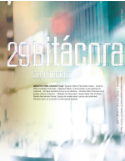Movie Theaters' Illuminated Façades: The Emergence of the Cinemas in the Urban Night Landscape, 1920–1940
Main Article Content
Abstract
During the 1920s and 1940s, the exterior architecture of the buildings designed to host the cinematographic shows acquired aesthetic and formal characteristics that made of it an unmistakable and essential referent of the landscape’s night decoration in cities. The present article addresses the evolution that this architecture had in different settings, the grammar of a commercial architecture that prioritized on its exterior configuration the use of lighting. Our analysis enquires about the importance acquired by a technical aspect that during two decades defined and guided the adopted tendencies by owners, designers and builders of the complexes as a distinctive trait of an architectural typology developed in the first half of the twentieth century.
Article Details
Citas en Dimensions Service
Bitácora Arquitectura by Universidad Nacional Autónoma de México is licensed under a Creative Commons Reconocimiento-NoComercial-SinObraDerivada 4.0 Internacional License.
Creado a partir de la obra en http://arquitectura.unam.mx/bitacora.html.
